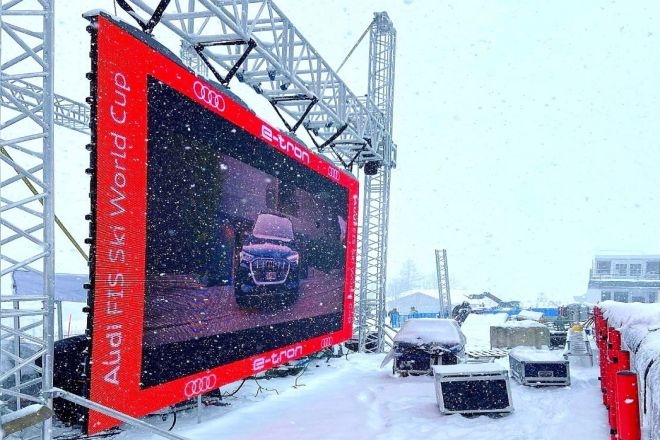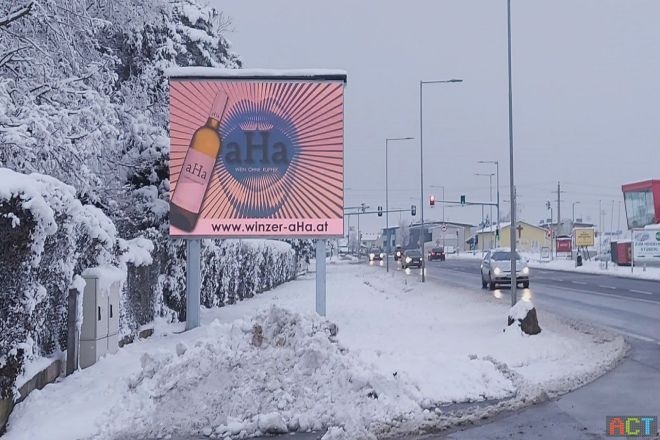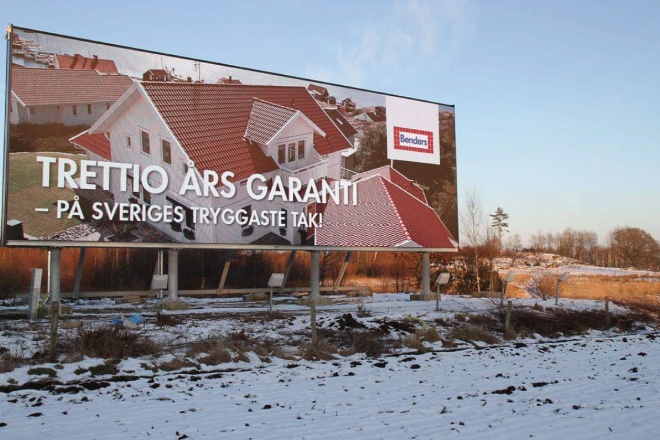소개

As the end of 2024 approaches, most countries in the northern hemisphere have now entered winter. When winter comes, LED 디스플레이 will face a “new” test.
We all know that some countries will have very heavy snow in winter, so can 야외 LED 디스플레이 be frost-proof in heavy snow? This article will help you explore what to do with LED displays in winter.
1. What are the specific challenges for outdoor LED displays in winter?
As soon as winter comes, our outdoor LED displays will suffer and have to face many “small tests” in nature. Don’t look at these big screens that are usually bright and beautiful.
When winter comes, they also have to “shiver” a few times. Let’s talk about what troubles winter brings to these displays.
1). Low temperature
First of all, low temperature is really a headache. Do you know that those LED lamp beads and circuit boards are actually quite afraid of the cold?
When the temperature is low, their “vitality” is reduced, just like our hands and feet are not flexible when we are cold. As a result, the 명도 of the LED display is dim, the colors are not so bright, and it looks a bit “unspirited.”
Moreover, low temperatures will also make the power supply and control system angry. The small parts in the power supply, such as electrolytic capacitors, will not work when it is cold, and the LED display may not start or work unstably. The control system may also be “confused” because it is too cold, causing various strange problems on the display.
2). Troubles of ice and frost
In winter, snow and ice are common. This is not a good thing for outdoor LED displays. Once water freezes or frosts on the display, it will be troublesome.
The circuit may short-circuit due to moisture, and the electronic components may also be frozen. Just like our mobile phones are soaked in water, the LED display may also “go on strike” because of this.
Also, those ice cubes and icicles, although they look beautiful, are not light in weight. If they accumulate on the display for a long time, the structure of the LED display may not be able to withstand it, and it may break or deform, which is not worth the loss.
3). The “baptism” of wind and snow
In winter, the wind is strong, and the snow is heavy, which is also a big challenge for outdoor LED display screens. The wind and snow are like “small knives” that keep scraping on the display screen.
Over time, the surface of the outdoor LED display screen may be worn and look less smooth. Moreover, if the snow accumulates on the display screen, everyone can’t see anything, just like being blind.
Also, although the snow looks white and clean, it is actually quite “troublesome.” When the snow covers the display screen, it will block the heat dissipation channel and make the inside of the display screen hot.
In this way, the burden on the display screen is increased, and it may malfunction due to overheating. The wind is not a good thing, either. If it is too strong, it may also blow the display screen loose or even blow it badly.
2. What are the antifreeze measures and maintenance strategies for LED display screens?

Winter is coming, and our LED display screens must also be “warmed” well; otherwise, they will be upset with you. Don’t worry, and I will give you a few tips to keep your display screen safe and secure through the winter!
1). Pick a “cold-resistant expert”
First of all, you have to be careful when choosing an outdoor LED display. There are LED displays on the market that are designed for extremely cold environments, and they are all “cold-resistant experts.”
These outdoor LED displays have a very thick insulation layer, just like putting on a big cotton-padded jacket for the display, and the heat is not easy to dissipate. Moreover, the components inside are also cold-resistant. Even if it is as cold as an ice cellar outside, they can still work normally, and the brightness and color are not discounted at all.
2). “Add clothes” to the outdoor LED display
If you think your outdoor LED display is not cold-resistant enough, then “add some clothes” to it. Stick some insulation materials on the back and sides of the outdoor LED display, such as foam boards, rock wool, etc., so that the heat will not easily escape.
In addition, you can also consider installing a heating element or a constant temperature system for the display, just like installing a small heater for the display so that it is always warm inside.
3). Waterproof and moisture-proof are essential
In winter, rain and snow are common. You have to make sure that the outdoor LED display is waterproof and moisture-proof. Otherwise, it will be troublesome if water seeps in.
So, when choosing a display, you must choose one with a high waterproof rating, preferably IP65 or higher. Also, don’t forget to check the drainage system regularly to prevent the accumulated water from freezing inside and “freezing” the display.
4). Intelligent temperature control to help
Nowadays, technology is becoming more and more advanced. Some outdoor LED displays are equipped with intelligent temperature control systems.
This system, like a caring assistant, will automatically adjust the working temperature of the display according to the ambient temperature or install air conditioners that can heat the structure of the outdoor LED display.
In this way, the display can always be kept in the most comfortable state, neither too hot nor too cold, which is much easier to use.
5). Daily inspections are essential
Finally, don’t forget to inspect the outdoor LED display daily. Check it every now and then to see if the brightness is enough, the color is correct, and the response speed is fast. If you find ice and frost, deal with them quickly.
Don’t let them affect the “appearance” of the display. In addition, snow must be cleared in time; otherwise, the display will be suffocated. Don’t forget to check whether the cable connection is firm and the electrical system is stable so as to ensure that the display is always healthy.
In short, winter antifreeze is a big deal for LED displays. You have to take good care of them so that they can always bring you clear and bright visual enjoyment. I hope these tips and maintenance tips can help you and let your LED display spend the winter safely!
3. Winter emergency treatment plan for outdoor LED display screens
Alas, winter is coming, and outdoor LED displays will occasionally have a little temper, such as being covered with frost or suddenly not working. Don’t worry, and I will give you a few tips for emergency treatment to quickly restore your display screen to vitality!
1). Quick deicing and defrosting
In winter, snow and ice are common. If the outdoor LED display is covered with frost, it will be troublesome. Not only can it not be seen clearly, but it may also cause damage to the display. At this time, you have to quickly take out your “deicing artifact” – a low-temperature hair dryer! Note that it must be low temperature.
Otherwise, the temperature is too high, and the display is burned, which is not worth the loss. Blow gently, and the frost will soon disappear without a trace. Of course, if conditions permit, you can also use a soft cloth or a professional deicing tool to clean it. The key is to be quick and don’t let the frost stay on the display for too long.
2). Temporary heating measures
Sometimes, the display may “strike” because it is too cold. What should you do at this time? Don’t worry, I have a good idea! You can take out your portable heating device, such as a small heater, electric blanket, etc. (of course, make sure it is safe and reliable), and heat the area around the display.
Just like putting clothes on people, let the display feel warm. However, be careful when heating, don’t get too close to the display and burn it. Moreover, this is only a temporary measure. When the weather warms up, or a better solution is found, the heating equipment must be removed quickly.
3). Troubleshooting and repair
What if the display screen really fails? Don’t panic! At this time, you have to establish a rapid response mechanism. First, find a professional technician to take a look and see where the problem is. Is it a power failure or a control system problem?
After finding the problem, repair it quickly. Repair what can be repaired, and replace it with a new one if it cannot be repaired. Remember, time is money! Solve the problem early so that the display screen can resume normal operation early.
4. Long-term planning and prevention of antifreeze for LED display screens

1). Installation site selection considerations:
Site selection is a big deal when installing LED display screens. You have to look at the geographical location and climate factors first and find a place that is beneficial to the display screen.
For example, try to avoid the vent position to reduce the direct blowing of cold wind; choose a place with shelter to reduce the direct invasion of rain and snow; you can also consider the direction of the display screen so that it can get more sun and increase natural warmth. In this way, the display screen can work safely in a relatively warm environment.
2). Invest in upgrades:
Technology is always improving, and your display screen cannot lag behind! Timely technical upgrades of the display screen are a good way to improve its ability to adapt to bad weather. For example, replace a more cold-resistant LED lamp bead so that it can maintain brightness at low temperatures.
Upgrade the control system to make it smarter and more stable; you can also add a constant temperature system to keep the internal temperature of the display screen within a suitable range. These upgrades, although you have to invest some money in the early stage, in the long run, they can make the display screen more durable and less troublesome!
3). Training and education:
The antifreeze of the display screen still depends on people. Therefore, you have to provide professional training to maintenance personnel so that they are familiar with winter antifreeze knowledge.
For example, teach them how to quickly defrost and defrost, how to use heating equipment, how to troubleshoot and repair faults, etc. They also need to be “charged” regularly to keep up with the pace of technology.
In this way, your maintenance team can become the “guardian” of the display screen so that the display screen can be safe and sound in winter.
결론
By implementing scientific antifreeze measures and timely maintenance management, we can ensure that the outdoor LED display screen can still maintain efficient and stable operation in the harsh environment of winter.
마지막으로 LED 디스플레이 화면에 대해 더 알고 싶다면, 우리에게 연락해주세요.
